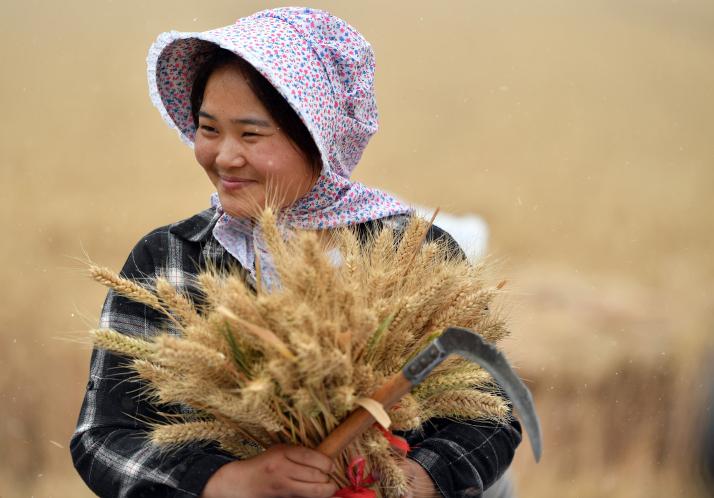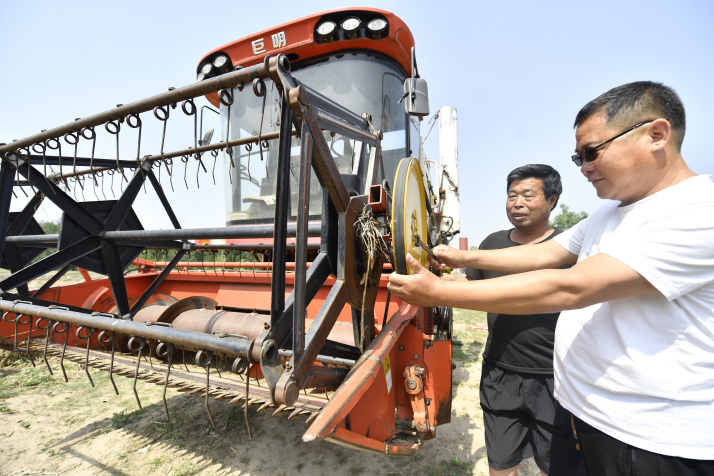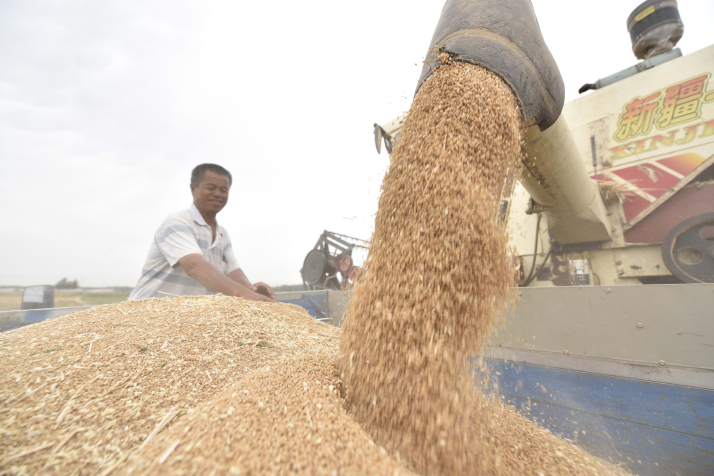| Editor's Choice |
| New policies and advanced techniques reap bumper summer grain harvest | |
| China's grain output has increased in spite of the COVID-19 epidemic because of the supportive policies rolled out by the Central Government to ensure resumption of farming in spring as well as the use of advanced technologies | |
|
|
 A farmer harvests wheat in Henan Province in central China on June 2 (XINHUA)
For months before the summer harvest, Liu Tianhua, the head of a rural cooperative, was on tenterhooks. The cooperative in Henan Province in central China had sown wheat over 3,000 hectares, a work of mammoth labor that had been made even more arduous by a series of problems. First, the novel coronavirus disease (COVID-19) outbreak in spring interrupted farming and then the wheat was infected by stripe rust, a fungal disease, followed by dry weather in May. However, after harvesting started at the end of May and was nearly completed within a week, Liu could finally heave a sigh of relief. It was a bumper harvest. Farmers nationwide shared the same exhilaration, as on June 15, when 90 percent of the summer grain had been harvested, there was official confirmation of the plentiful yield. The Ministry of Agriculture and Rural Affairs announced a bumper summer grain harvest, with wheat yield being particularly impressive. The wheat output per unit had increased and the quality had improved, according to the ministry. Predictions of a golden harvest were made earlier this month when the Chinese Academy of Agricultural Sciences (CAAS) released the China Agricultural Sector Development Report 2020 on June 3, which estimated grain output would reach 670 million tons this year, more than last year's 660 million tons. Summer grain, the first grain harvested every year, is crucial for the whole-year grain harvest. Yuan Longjiang, Director of the Institute of Agricultural Economics and Development, told news website Cnr.cn that the grain output has increased in spite of the COVID-19 epidemic because of the supportive policies rolled out by the Central Government to ensure resumption of farming in spring as well as the use of advanced technologies. Government support Grain production across the country faced severe challenges in the beginning of the year. Many companies manufacturing agriculture-related products such as pesticides and fertilizers couldn't resume production due to the epidemic. Transportation was disrupted, making it difficult to get supplies. Many family farms and rural cooperatives faced labor shortages as workers couldn't return to their posts after the Spring Festival holiday owing to travel restrictions to control the epidemic. All this also led to rising labor costs. To reduce the impact of the epidemic on grain production and facilitate spring planting, the Central Government took a series of measures to ensure grain production while carrying out epidemic control. This included measures to ensure supply of agricultural materials and machinery and facilitate the resumption of agricultural production. The government also maintained price floors for grains to protect farmers. It means that if the market price drops below the floor price, the government would come to the rescue and buy the grain so that the farmers will not suffer losses. This year's wheat floor price has been set at 2.24 yuan ($0.32) per kg, the same as last year, effective from June 1 to September 30. The floor price for rice is 2.42 yuan ($0.34) per kg, up 0.02 yuan ($0.003) against last year, effective from August 1 to September 30. The agriculture and rural affairs authorities monitored farms to prevent and control crop diseases such as stripe rust and head blight of wheat, and earmarked over 1.6 billion yuan ($225.6 million) for prevention and control of wheat diseases and pests. Wang Guang, a farmer in Shaanxi Province in northwest China, told People's Daily his wheat developed stripe rust but agricultural technicians helped him treat the disease promptly and as a result, his output increased. China has always implemented policies prioritizing agriculture as the foundation of the national economy, He Xiurong, a professor of the College of Economics and Management at China Agricultural University in Beijing, told Cnr.cn. This priority has been maintained even during the epidemic outbreak.  A technician from the local agricultural department helps a farmer repair a machine in Qiansunzhang, a village in Wenan County, Hebei Province in north China, on June 5 (XINHUA)
Science for growth Advanced technologies have played a key role in improving this year's grain output and quality. Xiao Shihe, chief scientist of the National Wheat Industry Technology System under CAAS, said agricultural experts detected the outbreak of stripe rust immediately and advised the local agricultural departments on how to prevent and control the disease, which proved effective in controlling it before it could spread. Yun Quancai, a farmer in Gaotang County, Shandong Province in east China, saw his wheat develop yellow stripes in April. He took a photo and showed it to the county plant protection department. The head of the department went to his field to check the crop, diagnosed it as stripe rust, and told him how to control it. In the same way, local agricultural technicians checked all the wheat fields in the county and instructed farmers how to treat diseases. Du Lizhi, Deputy Director of the Department of Agriculture and Rural Affairs in Yun's county, said although this year wheat pests and diseases were more severe at the onset, their effect on the output was negligible due to the timely action taken by the agricultural technicians. Many farmers used technology to save pesticides, fertilizers and water. In north China, lack of water for irrigation is a major factor affecting wheat cultivation. To circumvent this, scientists have developed hardier varieties that can survive on little water. A research team from the Hebei Academy of Agricultural Sciences in Hebei Province cultivated 27 varieties that can resist drought and use little water and the improved versions were planted in over 13 million hectares. When Ding Xinbei, a farmer in Laiyang in Shandong, planted wheat on over 100 hectares, the weather was dry and he felt the harvest wouldn't be good. However, the technicians taught him how to conserve water and fight drought and he managed to have a bumper harvest. This year, the combination of water-saving varieties and water-saving cultivation techniques will save about 30 percent of irrigation water in wheat production compared with the traditional production method, according to China Central Television. Advanced technologies such as the Internet of Things are also being used in farming. In Shangshui, a county in Henan, Qiu Shouxian, a farmer who planted wheat on 140 hectares, used the Internet of Things to monitor pests and diseases, the weather and soil in his farm. He checked the growth of his crops on the phone and watered them or sprayed pesticide by pressing buttons on the phone, triggering remote controlled sprinklers. Greater mechanization has also boosted the yield. In Yaojiazhuang, a village in Jinzhou in Hebei, the head of a local cooperative told People's Daily that in the past, nearly 70 people were needed to harvest the wheat grown on the cooperative's land. Now the same amount of work is done by 10 harvesters and their 10 drivers. New types of agricultural businesses have also contributed to this growth in the use of technology. There are over 2 million registered rural cooperatives in China at present, which offer diverse services to nearly half of all farmers, such as providing hi-tech equipment. Around 18 percent of rural cooperatives specialize in grain planting. Lin Chuanyu, a farmer in Lanling, a county in Shandong, said in the past it took at least 20 days to plow his land. This time with the machinery provided by his rural cooperative, he did it in just two days.  A farmer loads harvested wheat onto a truck in Xinghuliu, a village in Liaocheng, Shandong Province in east China, on June 15 (XINHUA)
High-standard farmland In addition to these measures, the development of high-standard farmland is a foundation for guaranteeing grain supply. The quality of farmland can be improved by joining small plots owned by different farmers so that greater resources can be invested in the land, including production techniques that consume less water, pesticide and fertilizer. In the past four years, Nantong, a city in Jiangsu Province in east China, invested over 5 billion yuan ($705 million) to build over 130,000 hectares of high-standard farmland. The city's arable land has increased by over 4,000 hectares and grain production capacity by 70,000 tons. Wu Jianxin, chief of the Party Committee of Yujiaba Village in Nantong, told Nantong Radio and TV Station that the new farmlands are more suitable for using agricultural machinery. The approach has reduced production costs and improved efficiency. The Report on the Work of the Government has said high-standard farmland will be increased by 5.33 million hectares this year. By 2022, the area will be increased to 67 million hectares, according to a guideline for ensuring grain security issued by the General Office of the State Council in November 2019. "High-standard farmland is mainly used for grain production to ensure basic self-sufficiency of grain and grain security," Yang Peng, head of the Institute of Agricultural Resources and Regional Planning, CAAS, said. He told Beijing-based China Science Daily that on average, after a field is built into high-standard farmland, the average gain yield will increase 1,500 kg per hectare. (Print Edition Title: A Safe Rice Bowl) Copyedited by Sudeshna Sarkar Comments to jijing@bjreview.com |
|
||||||||||||||||||||||||||||
|
